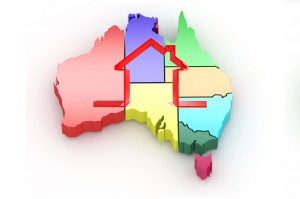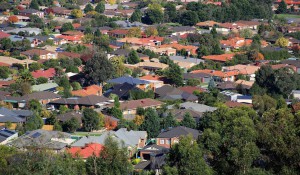Housing affordability is becoming a very hot political topic at the moment and it is no wonder why.
When we look at the latest CoreLogic Home Value Index results for February 2017, they show that combined capital city home values increased by 1.4% taking them 11.7% higher over the past year.
Since the end of 2008, combined capital city dwelling values have increased by 66.2%.
It is really important to note that the housing affordability challenges are largely a Sydney and Melbourne phenomena.
The above chart highlights the change in dwelling values across the individual capital cities over the past 12 months.
The annual rate of growth has accelerated over the past six months in Sydney, Melbourne and Canberra, in fact, the annual rate of growth in Sydney is now at its highest level since December 2002.
Sydney and Melbourne have seen substantially higher levels of dwelling value growth over recent years compared to the other capital cities.
In 2008, dwelling values fell by -6.1% between March and December of that year.
From December 2008 dwelling values started to rise on the back of aggressive interest rate cuts and stimulus for first home buyers.
Since that time, values have increased across all capital cities however, the rises in Sydney and Melbourne have been substantially higher than elsewhere.
This points to the fact that it isn’t one policy decision driving the market, there are also broader economic and demographic factors to consider.
All cities have the same interest rate, the same ability to negatively gear property and all incur the same level of capital gains discount yet the market performances are vastly different.
While in percentage terms the growth in NSW population has been lower than many other states, it is also important to look at population growth in raw number terms especially given NSW and Vic have much higher populations than the other states in territories.
Between December 2008 and June 2016, the increase in population across each state and territory was recorded at: 724,102 persons in NSW, 754,757 in Vic, 568,922 in Qld, 110,303 in SA, 408,244 in WA, 17,354 in Tas, 22,354 in NT and 45,040.
NSW and Vic have overwhelmingly seen a much greater increase in population over this period with most of the population flowing into Sydney and Melbourne.
Qld has had the third highest rate of population growth over the period however, it is important to remember that less than a half of the state’s population live in the capital city compared to almost 65% of the NSW population living in Sydney and 76% of Vic’s population living in Melbourne.
The substantial increase in the population of the two largest states has fuelled increasing demand for housing.
Especially when you consider that 51.8% of NSW population growth over the period and 62.6% of Vic population growth has come from either net overseas or net interstate migration.
Why do so many people choose to migrate to Sydney and Melbourne?
Because that is where the jobs have been created over recent years.
Between December 2008 and January 2017, 913,330 jobs have been created nationally, of these jobs 28.9% (263,722) have been created in Sydney and 33.8% (308,698) have been created in Melbourne.
The two largest capital cities that combined account for around 40% of the national population have created 62.7% of all new employment since the end of 2008.
It is clear that both domestic and international migrants are moving to where the jobs are being created, currently the best opportunities for employment are in Sydney and in Melbourne.
These migrants need somewhere to live and many coming from overseas and interstate are migrating for well-paying jobs which allow them to purchase residential property.
Now that we can understand the increasing demand for housing in Sydney and Melbourne due to stronger economic conditions and subsequent heightened population growth are propelling values higher, what can be done about it?
Ultimately, a solution comes down to both supply and demand.
Increasing the supply of housing will help but reducing the level of demand for housing could also help to alleviate some of the upwards pressure on housing prices.
The supply of housing can be increased by building more homes, as has occurred over recent years, however, just building more homes is not necessarily enough.
The people that have the greatest difficulty entering the housing market are those on low and middle incomes.
Expensive brand new units in inner-city areas and housing on the fringe that has a substantially high land value do not help to approve housing affordability.
Increased housing supply is the key but it has to be at a price point which is affordable for those that are currently locked out of housing.
Land zoning restrictions and the raft of development charges are ultimately passed on to the purchaser increasing the cost of new housing.
Furthermore, the private businesses that build new homes have no incentive to greatly increase supply given it will reduce the profitability of a new development.
Demand in Sydney and Melbourne is being fuelled by heightened levels of population growth, especially migration, strong job creation and low mortgage rates.
Furthermore, the recent strong level of value growth has attracted an increasing number of investors to purchase a property in Sydney and Melbourne.
If the goal is to slow the rate of growth in Sydney and Melbourne dwelling values (and I think it should be) curbing demand is a key way to do this.
One obvious way to curb the demand for housing in Sydney and Melbourne is to create demand elsewhere, this may eventually lead to affordability challenges in these alternate regions in the future.
Other ways to dampen demand which have been suggested include: removing or changing negative gearing, removing or reducing the capital gains tax discount or a tax on vacant properties.
Keep in mind that negative gearing and the capital gains tax discount are available nationwide however, dwelling value growth has only been excessive in recent years in Sydney and Melbourne.
Over recent years the level of investment purchasing has reached record highs and changes to negative gearing and the capital gains tax is likely to make investment less attractive.
A vacant land tax should at the very least encourage owners to make unutilised housing available for occupation.
The challenge will be making the tax substantial enough to encourage people to rent out the home.
The other source of demand over recent years which has driven demand in Sydney and Melbourne is foreign investment.
Unfortunately, regular and accurate data on foreign investment is unavailable, but anecdotally, demand from offshore over recent years has been much higher than it has been in the past.
From a political perspective, politicians do not want to see the cost of housing falling.
We are taught that deflation is undesirable and deflation in the value of the country’s most valuable asset class would have a much broader impact on the economy.
Keep in mind as well that every property that is rented is owned by someone, some are owned by Government but most rental properties are owned by private citizens.
The above chart pairs the number of dwellings according to the Australian Bureau of Statistics (ABS) with data on the number of outstanding mortgages to Australian authorised deposit-taking institutions (ADIs) data from the Australian Prudential Regulation Authority (APRA).
By pairing the two you get a proxy for the number of households that have outstanding mortgage debt to an Australian ADI.
At the end of September last year, 57.6% of the housing stock nationally was mortgaged to an Australian lender with that figure having increased from 49.2% year earlier (keep in mind this analysis assumes that there is only one outstanding mortgage per household which may not be the case).
What that means is quite a large number of dwellings are owned outright however, a majority are still mortgaged and ultimately owners of those properties do not want to see the value of their asset decline.
From a political view the best way to improve housing affordability is to see growth stall for a number of years.
This has recently happened in all housing markets outside of Sydney and Melbourne with values having underperformed inflation, it has definitely not been the recent case in the two largest cities.
The way to achieve this is to undertake a wide range of both demand and supply reforms which increase the amount of housing, particularly affordable housing, available to purchase or rent.
Demand for housing in Sydney and Melbourne also needs to be slowed.
This can be done via deterrents such as making investment less attractive in these markets through additional fees and charges or changes to the tax system or looking to partner with business to make other locations more desirable by creating more jobs outside of the two largest capital cities.
The other way to slow demand in Sydney and Melbourne would be to consider reducing the level of migration to Australia.
Supply side reforms should look at increasing housing supply but this must be done at more affordable price points which means reducing development costs.
Governments also need to find ways to discourage developers from holding vast amounts of developable land back from the market and perhaps a tax on undeveloped residential zoned land is a good way to do this.
Supply and demand side reforms will be no easy feat and will require cooperation from all levels of government.
But these reforms are vital because it is clear that after such a significant and sustained surge in dwelling values over recent years more needs to be done to temper the growth in the Sydney and Melbourne housing markets.












No comments:
Post a Comment